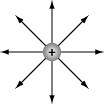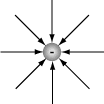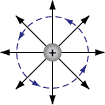|
How Antennas Work
We can't see them but radio and television waves are just another
form of light. They have a much longer wavelength than visible light
but both are electromagnetic radiation.
To generate radio and TV waves we typically make electrons oscillate
up and down on an antenna. This is done by applying a variable
voltage or alternating current to the antenna. Antennas are
generally made of metals and metals act like containers filled with
a liquid made of electrons. Metal atoms have one or more weakly held
electrons in their outer shells which can "float" from atom to atom.

Figure 1. Electric
Field Around a Positive Charge
When a negatively charged electron moves it leaves behind what is
generally referred to as a positively charged hole. The hole is
simply an atom with more positive protons than negative electrons.
The electrical fields for the two types of charges are shown in
Figures 1and 2. These are ray diagrams. The arrows show the
direction of the force that would be exerted on a unit of positive
charge.
Unlike a vector diagram, the length of a ray does not indicate the
magnitude of the force. Instead, the space between rays indicates
magnitude. Both diagrams in Figures 1 and 2 show that the magnitude
of the field decreases with increasing distance from the charge
because the space between the rays increases.

Figure 2. Electric
Field Around a Negative Charge
We can use a simple analogy to help
understand how electromagnetic waves are produced by moving charges.
Imagine for a minute that the rays or electric field lines shown in
Figures 1 and 2 are like very long springs attached to a circular
frame with the charge at the center, almost like a trampoline. If
the charge is bounced up and down waves will propagate outward along
the springs. Yes, the world of electromagnetic radiation is far more
complex than our simple analogy but hopefully it gives you some idea
of how a moving charge could create a wave.
The waves and variation in the electric field account for the
"electro" part of the term electromagnetic waves.
A moving charge is essentially a current and currents create
circular magnetic fields. In Figure 3, a positive charge moving
straight out of the page would produce a magnetic field represented
by the blue dashed line. The direction of the field can be
determined using the right hand thumb rule. The thumb is pointed in
the direction of the current and the fingers of the right hand
wrapped into a loose fist. The fingers point in the direction of the
magnetic field.
Note that the magnetic field lines are perpendicular to the electric
field lines. This is one of the famous characteristics of
electromagnetic waves.

Figure 3. Magnetic
Field (shown in blue)
Created by a positive
Charge Moving Straight out of the Plane of the Page
Okay, you're probably wondering why we
use an example of a positive charge when we just got finished saying
that it's the electrons which move. It turns out that all the
conventions in electricity and magnetism are set up for positive
charges. Much of this can be traced back to the work of Benjamin
Franklin. Unfortunately, the electron had not even been discovered
in Franklin's time.
When we talk about current we pretend the positive holes are
actually moving in the opposite direction as the electrons. It may
seem pretty silly but it does work as a concept and so we're
sticking with the tradition.
If a variable voltage is applied, it will send an electrical wave up
an antenna. Free electrons in the antenna act as the media for
propagating the wave. The situation is similar to longitudinal sound
waves propagated in a metal rod. The sound wave is carried by
alternating regions of tension and compression. In the compressed
areas the rod's molecules are pushed a little closer together. In
the tension areas they are pulled a little further apart. Although
the molecules barely move, the sound wave can be transmitted great
distances.
The very slight motion of electrons up and down an antenna is enough
to cause electromagnetic waves to radiate out the sides of the
antenna at the same frequency as the variable voltage applied to it.
These are used for transmitting radio and television signals as well
as other forms of wireless communication.
Like sound, when electrical waves at a defined frequency hit the end
of an antenna they are reflected backwards and form a standing wave
in the antenna. Antenna waves move at the speed of light (3 x 10 8
m/s) and so the travel time from one end of the antenna to the other
is pretty quick.
The electrical waves created on antennas typically have a fixed
wavelength. If the length of the antenna is wisely chosen it's
possible to make it resonate. The free end of an antenna acts like
an open circuit. Voltage drop is maximum across an open circuit and
zero across a short circuit. Hence the end of an antenna forms an
anti-node or area of maximum voltage or e-field strength. A node is
a point which has zero e-field. The distance between an anti-node
and node is a quarter of a wavelength.
The wavelength of an electromagnetic wave is calculated as follows:
λ = C / f
Where:
λ = wavelength
C = speed of light (3 x 108 m/s)
f = frequency
Figure 4 shows a dipole antenna which is
generally considered the simplest form of antenna. In this case each
half of the antenna is roughly 1/4 wavelength long with the antenna
fed from its center. Hence, the total antenna is 1/2 wavelength
long. The ends of the antenna correspond to anti-nodes and the
center to nodes. This configuration causes the antenna to resonate.
An antenna will still transmit even if the length is not ideal for
resonance. However, less of the power input to the transmitter will
actually show up as useful output signal. In other words, the
efficiency of the system will be significantly lower.

Figure 4. Dipole
antenna
Dipole antennas are considered balance
devices because they are symmetrical and work best when they are fed
with a balanced current. In other words, the current has to be of
equal size on both halves. This is usually accomplished with a
balun when the antenna is fed with a coaxial cable. Coaxial
cable is considered unbalanced, hence the word balun is
formed from parts of the words BALanced and UNbalanced. A balun
is basically a small transformer.
The optimum size of a dipole antenna is slightly different than
would be expected based on wavelength alone. This is due to the
interaction of the balun and antenna. However, the predicted
resonance length is usually very close to the length for optimum
broadcast efficiency.
Electromagnetic waves emitted from an antenna are generally modeled
as transverse waves. Since the waves have both electric and magnetic
field components and are emitted in three dimensional space, the
transverse wave model drawn in text books is a bit over simplified
but the full picture is almost impossible to draw.
Waves emitted from simple monopole and dipole antennas tend to be
polarized. In other words, if the emitting antenna is vertical the
receiving antenna also has to be vertical for best reception. If the
receiving antenna is horizontal the signal it picks up will be
greatly attenuated.
Antenna design is very complex and requires a lot of time and study
to master. However, any antenna will have to oscillate charged
particles in order to transmit radio signals and will tend to do
this best if the antenna is resonating.
Back to Contents
|



